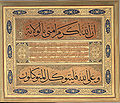Kazasker Mustafa Izzet Efendi
Kazasker Mustafa Izzet Efendi (Template:Lang-ota, Modern Turkish: Kazasker Mustafa Izzet Efendi) (alternative: Kadiasker Mustafa Izzet Efendi, Seyyid Mustafa) (b. 1801 Tosya - d. 16 November 1876 Istanbul), was an Ottoman composer, neyzen, poet and statesman best known for his calligraphy.[1][2]
Life and career
Kazasker Mustafa Izzet Efendi was born in Tosya, near the Black Sea in 1801. Following his father's death (his father was Destan Agazade Mustafa Aga), his mother sent him to Istanbul for an education. He studied Islamic theology and music and became an accomplished ney (reed-flute) player and had a delightful singing voice. He spent three years at the court of Sultan Mahmud II, but found court life to restrictive. He sought the Sultan's permission to make a pilgrimage to Mecca, and decided not to return to the Imperial Palace. Instead, he remained in Cairo before finally returning to Istanbul, but failed to return to the court. Some time later, when the Sultan discovered that he was in Istanbul, he was ordered to be punished but eventually he was pardoned. He went onto occupy judicial and religious posts in the court of Abdulmejid I. Among his duties, was to act as the calligraphy master to the royal princes.[3]
His major contribution to Ottoman calligraphy was to develop refined versions of sülüs and nashk scripts, based on the earlier work of Hâfiz Osman, Celaleddin and Rakim. However, his improvements were eclipsed by the work of Sevki Efendi (1829-1887) who perfected these styles to a level that has never been surpassed.[4]
His most notable calligraphic students were Mehmet Şefik (1818-1890);[5] Şefik Bey (1819-1880); Abdullah Zuhdi Effendi (1835-1879); Muhsinzade Abdullah Bey (1832-1899) and Hasan Riza Effendi (1849-1920).[6]
Work
His calligraphic inscriptions can be found inside many public buildings and mosques, including Ayasofya, Hırka-i Şerif, Buyuk Kasimpaya; Kucuk Mecidiye; Sinan Pasa and Yahya Effendi[7]
Calligraphy
-
A colorful copy of the introduction to the Koran in Nastaʿlīq script
See also
References
- ^ Kazasker Mustafa İzzet Efendi
- ^ Mustafa Kara, Vefatının 130. Yılında Kazasker Mustafa İzzet Efendi, Tasavvuf Dergisi, Sayı 8:, 2007
- ^ M. Uğur Derman, Letters in Gold: Ottoman Calligraphy from the Sakıp Sabancı Collection, N.Y., Metropolitan Museum of Art, 1998, p. 116
- ^ M. Uğur Derman, Letters in Gold: Ottoman Calligraphy from the Sakıp Sabancı Collection, N.Y., Metropolitan Museum of Art, 1998, p. 19
- ^ Bloom, J. and Blair, S.S. (eds), Grove Encyclopedia of Islamic Art & Architecture, Volume 1, Oxford University Press, 2009, p. 475
- ^ M. Uğur Derman, Letters in Gold: Ottoman Calligraphy from the Sakıp Sabancı Collection, N.Y., Metropolitan Museum of Art, 1998, p. 118
- ^ M. Uğur Derman, Letters in Gold: Ottoman Calligraphy from the Sakıp Sabancı Collection, N.Y., Metropolitan Museum of Art, 1998, p. 118 Note: Some of these inscriptions were enlarged from Izzet Effendi's original stencils.




